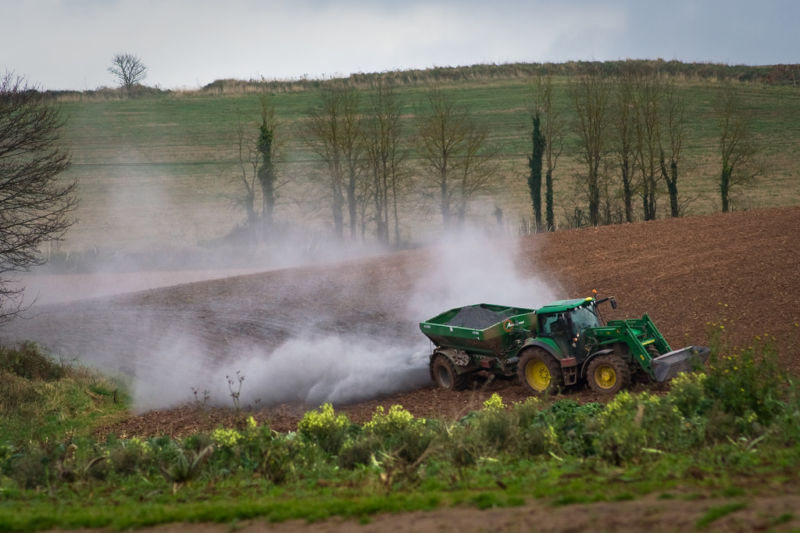Easy Way to Turn Rock Field Into Farmland
Crop dusting —
Crush the right rock and spread it on farms to help soil and the climate
Researchers run the numbers on what could be a win-win.

Enlarge / Instead of adding crushed limestone to soil, we could opt for basalt.
The best response to a leaking pipe is to stop the leak. But even if you haven't quite got the leak solved, a mop can keep the pool of water on your floor from spilling into the next room.
That's kind of the situation we're in with our emissions of greenhouse gases. The only real solution is to stop emitting them, but anything that removes existing CO2 from the atmosphere could help lower the peak warming we experience. Some techniques to do that sound like pipe dreams when you consider scaling them up, but others can plausibly make at least modest contributions.
A new paper from a group of authors led by David Beerling of the University of Sheffield argues the case that something that sounds a little wild—spreading crushed basalt over the world's croplands—could actually be pretty practical.
Basalt and some other types of rock loaded with silicate minerals remove CO2 from the atmosphere as they weather thanks to chemical reactions with water. Carbon dioxide dissolved in rainwater is turned into bicarbonate, which trickles away in groundwater or rivers and eventually reaches the ocean. This process has had a huge impact on greenhouse gas concentrations over Earth's history but does so only slowly. It would have to be put on steroids to be helpful within the next century.
One way to do that is to bring the CO2 to the rock—injecting compressed carbon dioxide into basalt bedrock, for example. But you can also bring the rock to the CO2 by crushing basalt into powder and spreading it over land. The tremendous increase in surface area when you crush up bedrock allows those weathering reactions to go much, much faster.
You might be surprised to learn we already commonly do something like this on agricultural land—just with the wrong kind of rock. Farmers often add crushed limestone to their fields to counteract soil pH changes resulting from fertilizer application. Unfortunately, acidic soils can actually cause some of that limestone (which is calcium carbonate) to transform into CO2, which is released into the air.
But crushed basalt could do the same pH-adjusting job while providing a variety of additional benefits. Weathering basalt minerals will release nutrients, including phosphorus. (Think of the fertile soils that develop in volcanic areas—basalt is a volcanic rock.) Basalt could help maintain good soil structure and slow erosion.
And the climate benefit, of course, is that every ton of weathering basalt can remove about 0.3 tons of CO2 from the atmosphere. To show what this might reasonably add up to, the researchers spitball a typical application rate to two-thirds of the world's croplands. That could pull about 0.5 to 4 billion tons of CO2 per year out of the atmosphere.
That's not a huge number when you compare it to the approximately 41 billion tons the world is currently emitting each year. But the authors note that analyses of how to limit global warming to 2 degrees Celsius call for about a 1 billion-tons-per-year reduction from agriculture by the year 2030. That's approximately what this could provide.
Obviously, there is no free lunch, and the problem here is quarrying, crushing, and transporting all that basalt. The more fossil fuel energy you use in that process, the more of the CO2 benefit is lost and the worse the ecological side-effects. The amount of basalt we would need to do this is about equivalent to the world's mineral mining operations—though much less than the world's quarrying for construction materials.
The authors point to a couple of possibilities here. First, renewable energy could be used to power things like crushing machinery, maximizing the net removal of atmospheric CO2. But there are also large volumes of suitable rock currently being pushed to the side as waste. Examples include open-pit mining operations, which may remove lots of rock covering the deposits they're after. Other quarries have no use for material that comes out in small pieces. And even waste slag from the production of steel contains similar minerals and has already been used as a cheap soil additive in some places. So it's possible that existing waste material could be "recycled," reducing the need to quarry more basalt.
An abundance of research would have to be done to fully understand the costs and benefits and to guide the design of such a scheme, but it isn't hard to imagine switching out crushed limestone and replacing it with crushed basalt. The authors point out that "effective climate change mitigation requires an expanding portfolio of actions for extracting and sequestering CO2, alongside urgent reductions of CO2 emissions," so another option never hurts.
What's more, the nations that either have been or are becoming the biggest emitters conveniently also happen to have the most potential for CO2 removal in this way.
Nature Plants, 2018. DOI: 10.1038/s41477-018-0108-y (About DOIs).
marchantallis1956.blogspot.com
Source: https://arstechnica.com/science/2018/02/spreading-crushed-rock-on-farms-could-improve-soil-and-lower-co%E2%82%82/
0 Response to "Easy Way to Turn Rock Field Into Farmland"
Post a Comment